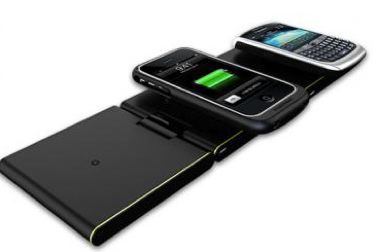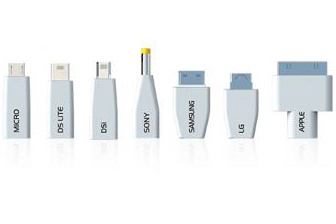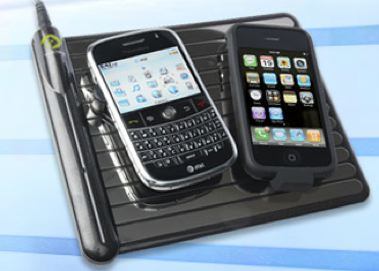Travel Tips
Power Mats: One-Stop Charging for Portable Electronic Devices
 Tired of tangled wires and mismatching power plugs?
Tired of tangled wires and mismatching power plugs?
Gadget guy Phil Baker tests out the new generation of power mats, where your portable electronic devices can sit in one place and charge up neatly and efficiently whether in a hotel, office or at home.
Accompanying all of our elegant portable devices are very inelegant ways of keeping them charged: ugly power adapters that seem like afterthoughts, tangled wires and too-few outlets.
Necessity is the mother of invention, so this has spawned all sorts of creations, from chargers with multiple tips to power strips with rotating sockets, to charging stands that accommodate multiple devices.
 One of the most promising solutions, in theory at least, is the power mat concept. The concept was shown several years ago at the Consumers Electronics Show—a flat rectangular plate that you drop your devices onto, which magically charges them using magnetic induction (similar to how some electric toothbrushes charge). But for it to catch on it required many manufacturers to standardize on the same technology; something that never happened.
One of the most promising solutions, in theory at least, is the power mat concept. The concept was shown several years ago at the Consumers Electronics Show—a flat rectangular plate that you drop your devices onto, which magically charges them using magnetic induction (similar to how some electric toothbrushes charge). But for it to catch on it required many manufacturers to standardize on the same technology; something that never happened.
The concept languished until Palm developed the Touchstone, a small pedestal on which you set a Palm Pre, held in place by magnets. Induction transmits power from the pedestal to the Pre.
Recently, several companies have introduced similar systems that offers some of the same convenience to all of your portable electronic devices. Each system consists of a flat plate and add-ons to the devices that bring connections from their charging ports to the plate.
 I’ve been trying out two products, the Powermat and WildCharge. They each use different technology, but they work in similar ways. Each system offers add-on “cases” for the iPhone, BlackBerrys and a few other popular devices that enable the connection between the phone and the plate. For other products they provide an add-on pad with a cable that plugs into the charging port of the device. You lay the case or pad on the plate to begin charging.
I’ve been trying out two products, the Powermat and WildCharge. They each use different technology, but they work in similar ways. Each system offers add-on “cases” for the iPhone, BlackBerrys and a few other popular devices that enable the connection between the phone and the plate. For other products they provide an add-on pad with a cable that plugs into the charging port of the device. You lay the case or pad on the plate to begin charging.
The iPhone cases looks much like many of the black plastic or rubber phone cases sold in the Apple store. The plastic case from Powermat lets you sync without removing the iPhone from its case.
No handy power sources? Get Portable Power for Travel Gadgets & Gear
WildCharge’s plate has parallel metal rails. When you lay the case or disc on the mat, contacts complete the path, allowing the current to flow.
Devices can be placed anywhere on the plate so it’s possible to charge four or five at a time. If you accidently drop a paper clip on the surface of the WildCharge and create a short circuit, it shuts down momentarily and causes no harm. The Powermat is limited to three on the plate, but also adds a USB port to charge a fourth.
 How energy efficient are these devices compared to a normal wall charger? The induction technology used on the Powermat, according to a company spokesman, is about 90 percent efficient, meaning 90 percent of the energy from the plate reaches the device. The WildCharge is 100 percent efficient.
How energy efficient are these devices compared to a normal wall charger? The induction technology used on the Powermat, according to a company spokesman, is about 90 percent efficient, meaning 90 percent of the energy from the plate reaches the device. The WildCharge is 100 percent efficient.
Additional losses occur from the wall adapter. Powermat claims it loses less wall power than most at 18 percent, and that it also saves energy by detecting when a device is fully charged and turning off the circuit.
Because these products use a single wall charger to charge multiple devices, the energy that power adapters consume when they’re not charging is reduced. The bottom line is compared to conventional chargers, these are not green devices offering energy savings, but they’re not huge energy wasters either.
The value of these products comes down to their convenience. It’s simpler to drop your device on the plate than to plug it in, and it reduces wear and tear on the connector, usually the weakest point.
More from gadget guy Phil Baker:
After using both the Powermat and WildCharge to charge my iPhone, Bluetooth headset, and a Sprint Android Hero phone, all simultaneously, I found both to be similar in convenience and performance. I’d usually just lay my phones on the plate while at home and they would be close to fully charged when I went out. In the case of the headset I needed to plug in a cable so it offered no advantage other than keeping everything in one place.
 While the Powermat uses the more advanced conductive technology, it comes at a higher cost and is a little bulkier. The Powermat is particularly well-styled and packaged and its AC adaptor is one of the cleverest I’ve seen with its housing serving as a reel to store the cable.
While the Powermat uses the more advanced conductive technology, it comes at a higher cost and is a little bulkier. The Powermat is particularly well-styled and packaged and its AC adaptor is one of the cleverest I’ve seen with its housing serving as a reel to store the cable.
The WildCharge is packaged much more cheaply, but more environmentally friendly.
The retail cost for the Powermat and accessories needed to charge an iPhone, Bluetooth headset and a second cell phone is $170. A similar configuration from WildCharge items costs $100. (Some of these products are heavily discounted online.)
The WildCharge is slightly more portable, but Powermat also offers a folding version of the plate in a convenient carry case that’s designed for travel.
Each of the products offers a promise of simplicity and easier charging, but that’s dependent on the devices you have, and whether you’re willing pay for it.
By Phil Baker for PeterGreenberg.com. Originally published in the San Diego Transcript. You can read Phil’s blog at blog.philipgbaker.com, and click here to purchase his book, From Concept to Consumer: How to Turn Ideas into Money (FT Press, October 2008).
More from gadget guy Phil Baker:
- Portable Power for Travel Gadgets & Gear
- Office on Wheels: Rolling Briefcases for Business Travelers
- Great Gadgets for Business Travelers
- Pros & Cons of Top Carry-On Bags for Laptops
- Travel Gadget Spotlight: Packing More In Your Carry-On
- Great Games & Travel Apps for the iPhone
- “Checkpoint-Friendly” Computer Cases: Worth It?












